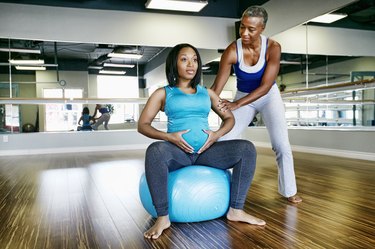
After you give birth to your beautiful baby, you likely don't have ample time carved out for yourself — it's a normal juggling act for new parents!
However, once approved by a health care professional, it's helpful to start fitting short workout routines into your day. A good place to start is with this 10-minute strength workout.
Video of the Day
"This is a stage in your life where you are going to need movement for your body and time to yourself more than anything," says Sasha Mihovilovic, CPT, a certified personal trainer, pre/postnatal corrective exercise specialist and master trainer at AKT. "This is so important to help with your mind, body and spirit."
Working out postnatal has several benefits, Mihovilovic says, which include:
- Re-establishing proper posture, core engagement and alignment
- Strengthening for holding an infant
- Reducing aches and pains
- Increasing self-esteem
- Decreasing chance of postpartum depression
- Reducing stress
"It's recommended that you wait until the six-week postnatal check with your doctor before commencing a group exercise program, returning to the gym or doing personal training," Mihovilovic says. "Everyone has their own unique physical and emotional journey with the birth of their child. This needs to be taken into consideration when starting up a new fitness routine."
If it's possible for you, it can be helpful to work with a personal trainer who has a pre/postnatal corrective exercise certification. If any of the following factors apply to you, share them with your instructor ahead of your workout:
- If you have diastasis recti, you should not include flexion and extension of the torso (like a stability ball crunch) in your workout until the gap is healed.
- If you're experiencing any bleeding, you should avoid putting your hips in an overhead position to help prevent an embolism (blood vessel blockage).
- If you are experiencing a separation of the pubic bone (symphysis pubis dysfunction), lateral movements (side-to-side exercises) should be eliminated or approached with extreme caution.
Tip
Always get the green light from your doctor or midwife before starting any postnatal exercise program.
How to Do the Workout
This workout includes a gentle warm-up followed by two sets of a strengthening workout. Take any necessary breaks and drink water as you need — and over time, you can work up to fewer breaks.
"These exercises are designed to bring awareness back to your deep intrinsic core muscles like the pelvic floor, transverse abdominal muscles and diaphragm," Mihovilovic says. "These muscles support the lumbar spine and create intra-abdominal pressure. Other movements here are also warming up the glutes, mindfully getting the body moving and promoting circulation."
Once you've completed the full-body interval, take a rest before going through it again (for two sets total). If you feel up to it, you can even add a third round, but be sure to rest as needed.
If at any point you feel faint, experience pain or something generally doesn't feel right to you, stop exercising immediately and contact your doctor.
Things You'll Need
- Chair or stability ball (optional)
- Yoga mat or something soft to lie on
- A set of light weights or wrist weights that are 2 to 5 pounds (optional)
- Towel and a bottle of water
The Warm-Up: Breathwork and Core Connection
1. Standing or Seated Core Breathing
- Start standing with your feet shoulder-width apart or seated (on any seat where your feet can firmly plant onto the ground). Place your hands on your stomach.
- Breathe in through your nose to engage your diaphragm, inhale to fill your lower rib cage with air and exhale using a “shh” sound. As you do so, close and lift your pelvic floor muscles (like a Kegel exercise) while you corset your abdominal muscles inward.
- Do this 10 times at pace that’s a little slower than your natural breathing.
2. Full-Body Reach Up/Down With Shoulder Roll and March
- Start standing with your feet shoulder-width apart and your arms hanging down by your sides.
- Bend your knees into half squat and reach your arms up overhead. At the same time, take a big breath in.
- Exhale as you lower your torso toward the ground so it's parallel to the floor and lower your arms so they're hanging down toward the floor.
- Return to standing position.
- Roll your shoulders backward one time.
- Lift your right knee up toward your chest to perform a single-leg march, then lower it back down.
- Lift your left knee up toward your chest to perform a single-leg march, then lower it back down.
- Repeat this entire sequence 8 to 10 times.
3. Supine Breathing
- Lie on your back with your arms resting by your sides, knees bent and feet flat on the ground hip-width apart.
- Place both hands on your stomach.
- Breathe into the lower rib cage through your nose, inflating your diaphragm for 4 counts.
- Exhale for 6 counts out using the “shh” sound, drawing your bellybutton toward your spine/down toward the floor. Hold it there for 4 counts.
- Repeat 10 times.
4. Pelvic Tilt and Hip Bridge Combo
- Lie on your back with your arms resting by your sides, knees bent and feet flat on the ground hip-width apart. Your feet should be close enough to your hips that if you reach one hand at a time toward each heel, you can just touch it with your fingertips.
- Relax your arms alongside your body. Think of your shoulders being "glued" to the floor to help keep your spine neutral.
- Tuck your pubic bone in toward your bellybutton, hold for 3 counts and release back to a neutral spine.
- Squeeze your glutes and core, and press your heels into the ground to drive your hips up toward the ceiling until you form a diagonal line from knees to hips to chest. Resist the urge to arch your lower back as you raise your hips. Focus on keeping your spine in a neutral position throughout.
- Hold at the top for 3 counts, then lower down.
- Repeat 15 times.
The Full-Body Strengthening Workout
Each of these exercises is timed for 30 to 40 seconds (without specific reps listed), so you can work at your own speed — focusing on form and breathing.
1. Squat Against Exercise Ball and Wall
- Place an exercise ball between your back and a wall. Stand against the exercise ball with your feet hip-width apart or slightly wider and your arms down by your sides.
- Slowly bend your knees as you push your hips back to lower toward the floor. Focus on lowering your body as if you were going to sit on a chair.
- Simultaneously extend your arms out in front of you, then lift them straight up to the ceiling so your biceps are in line with your ears.
- Squeeze your glutes and press through your heels to return to standing.
- At the same time, lower your arms back down by your sides.
- Repeat for 30 to 40 seconds.
Tip
If you don't have an exercise ball, you can do this move against a wall without one.
2. Dumbbell Row to Dumbbell Fly
- Holding light weights, stand with your feet together.
- Hinge forward from your waist at about 45 degrees, like you are about to pick up groceries, letting your arms drop naturally down from your shoulders.
- Draw your elbows up past your rib cage for a row, engaging through your upper back muscles and posterior deltoids. Release arms back down.
- With your elbows slightly bent, open your arms out to the side for a back fly, squeezing your rhomboids together. Release your arms back down.
- Lift your torso back up from hinge, keeping your bellybutton pulled toward your spine.
- Repeat for 30 to 40 seconds.
Tip
To make this move easier, you can use your body weight and not dumbbells.
3. Alternating Reverse Lunge With Chair
- Stand directly behind a chair with your feet shoulder-width apart and your toes pointed forward.
- Holding onto the back of the chair for balance, step your right leg back behind your body while simultaneously bending your left knee and lowering your hips. Keep your torso straight.
- Stop when your left knee is at a 90-degree angle and your left thigh is parallel to the floor.
- Pause slightly and press into your left heel, squeezing your glutes to stand up, while bringing your right leg back to the starting position.
- Repeat on the opposite side.
- Alternate legs for 30 to 40 seconds.
Tip
To make this move more challenging, you can do the reverse lunges without holding onto a chair and/or hold dumbbells at your sides.
4. Supine Transverse Abdominis March
- Lie on your back with your arms resting by your sides, knees bent and feet flat on the ground hip-width apart. Your feet should be close enough to your hips that if you reach one hand at a time toward each heel, you can just touch it with your fingertips.
- Relax your arms alongside your body. Think of your shoulders being "glued" to the floor to help keep your spine neutral.
- Inhale (expanding your diaphragm) and exhale (drawing your bellybutton toward your spine).
- As you exhale, lift your left leg a few inches off the ground, keeping your knee bent.
- Inhale to return your left foot to the floor.
- Exhale to lift your right leg a few inches off the ground, keeping your knee bent.
- Inhale to return your right foot to the floor.
- Continue alternating legs for 30 to 40 seconds.


